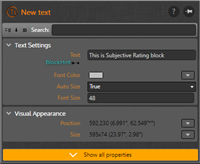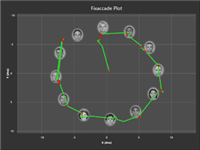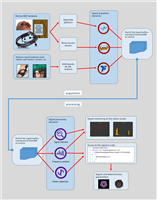Archives
-
26 Oct 2015

EventIDE uses a modern, hardware accelerated platform for GUI graphics, but in some cases the GUI could appear quite sluggish. The major GUI performance bottleneck is the property panel that lists properties of selected objects, such as events or element. When a new object is selected the property panel must generate a separate GUI control for every property. These controls include textboxes, dropdown list and popup editors. In an object has numerous properties, like Text element, its selection feels quite slow, taking a second or two to complete.
-
12 Oct 2015

XAML markup language is one of advanced features in EventIDE. XAML allows creating and editing vector graphics and interactive GUI layouts, both in the stimulus and status screen. Structurally, the XAML language resembles HTML providing a rich collection of tags, called elements. However, memorizing all XAML elements and their properties is not an easy task for a new user.
-
24 Jun 2015

Recently, we have expanded the EventIDE features with a new eye-tracking analysis AddIn. The implemented analysis performs real-time detection and labeling of fixations and macro/micro-saccades in eye-tracking data. The detection results can be plotted on the status screen, saved into a file, or used to control a flow of the experiment. You can add the eye-tracking analysis to any experiment designed in EventIDE.
-
03 Jun 2015

EventIDE stores stimulus materials compressed inside of the main experiment file. When an experiment is loaded, the materials get unzipped into a temporal folder for a run-time use. This model, albeit convenient in many cases, becomes too slows, when you use large video files as stimulus materials. Eventually, that such files need to be copied every time, as an experiment is opened, which can lead to annoying waiting times.
-
28 Jan 2015

We just have added a new EventIDE element, called Cedrus XID. The element monitors button presses, button releases and line states on the Cedrus input devices that support the XID (eXperimental Interface Device) protocol. The supported devices include the RB Series and Lumina response pads, StimTracker marker and SV-1 voice key. Initial testing of the new element confirmed its reliability and timing accuracy (the latter exceeds capacities of standard PC keyboards). If you have the Cedrus hardware and would like to try the new element, you can download the most recent EventIDE build on the website. EventIDE wiki contains an article on using the Cedrus XID element.
-
02 Jan 2015

Recently, EventIDE has got a new feature extension for real-time signal processing. It may sound complicated, but the new features are very simple to use. For example, with a few mouse clicks, you can launch monitoring and analysing EEG channels at the background of any experimental task. This post gives an overview of the new features, but first, you may watch our demo video:
